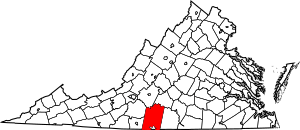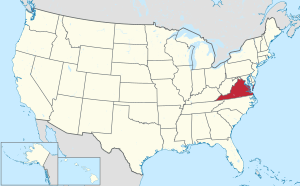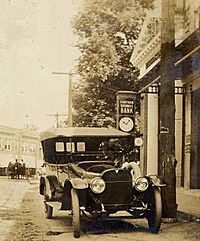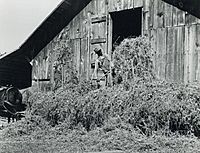Pittsylvania County, Virginia facts for kids
Quick facts for kids
Pittsylvania County
|
||
|---|---|---|

|
||
|
||

Location within the U.S. state of Virginia
|
||
 Virginia's location within the U.S. |
||
| Country | ||
| State | ||
| Founded | 1767 | |
| Named for | William Pitt | |
| Seat | Chatham | |
| Largest town | Chatham | |
| Area | ||
| • Total | 978 sq mi (2,530 km2) | |
| • Land | 969 sq mi (2,510 km2) | |
| • Water | 9 sq mi (20 km2) 0.9% | |
| Population
(2020)
|
||
| • Total | 60,501 | |
| • Density | 61.86/sq mi (23.885/km2) | |
| Time zone | UTC−5 (Eastern) | |
| • Summer (DST) | UTC−4 (EDT) | |
| Congressional district | 5th | |
Pittsylvania County is a county located in the Commonwealth of Virginia. As of the 2010 census, the population was 60,501. Chatham is the county seat.
Pittsylvania County is included in the Danville, VA Micropolitan Statistical Area.
The largest undeveloped uranium deposit in the United States (7th largest in the world) is located in Pittsylvania County (see Uranium mining in Virginia.)
Contents
History

Originally "Pittsylvania" was a name suggested for an unrealized British colony to be located primarily in what is now West Virginia. Pittsylvania County would not have been within this proposed colony, subsequently known as Vandalia.
The county was formed in 1767 from Halifax County. It was named for William Pitt, 1st Earl of Chatham, who served as Prime Minister of Great Britain from 1766 to 1768 and opposed harsh colonial policies.
In 1777 the western part of Pittsylvania County became Patrick Henry County.
Maud Clement's History of Pittsylvania County notes the following: ”Despite the settlers’ intentions, towns failed to develop for two reasons: the generally low level of economic activity in the area and the competition from plantation settlements already providing the kind of marketing and purchasing services typically offered by a town. Plantation settlements along the rivers, particularly at ferrying points, became commercial centers. The most important for early Pittsylvania was that of Sam Pannill, a Scots-Irishman, who at the end of the eighteenth century, while still a young man, set up a plantation town at Green Hill on the north side of the Staunton River in Campbell. (Clement 15)”
Its economy was tobacco-dominated and reliant on a growing slave labor force. It was a county without towns or a commercial center. Plantation villages on the major River thoroughfares were the only centers of trade, until the Danville emergence. (Clement 23)”
The city of Danville’s history up through the antebellum period overall is an expression of the relationship between the town and the planters who influenced its development.
Geography

According to the U.S. Census Bureau, the county has a total area of 978 square miles (2,530 km2), of which 969 square miles (2,510 km2) is land and 9 square miles (23 km2) (0.9%) is water. It is the largest county in Virginia by land area and second-largest by total area. The county is bounded on the north by the Roanoke River, intersected by the Banister River through the middle, and drained by the Dan River on the south.
Districts
The county is divided into seven districts: Banister, Callands-Gretna, Chatham-Blairs, Dan River, Staunton River, Tunstall, and Westover.
Adjacent counties and cities
- Bedford County, Virginia - northwest
- Campbell County, Virginia - northeast
- Halifax County, Virginia - east
- Caswell County, North Carolina - southeast
- Danville, Virginia - south
- Rockingham County, North Carolina - southwest
- Henry County, Virginia - west/southwest
- Franklin County, Virginia - west/northwest
Major highways
 US 29
US 29 US 58
US 58 US 311
US 311 US 360
US 360 SR 40
SR 40 SR 41
SR 41 SR 51
SR 51 SR 57
SR 57 SR 360
SR 360
Demographics
| Historical population | |||
|---|---|---|---|
| Census | Pop. | %± | |
| 1790 | 11,579 | — | |
| 1800 | 12,697 | 9.7% | |
| 1810 | 17,172 | 35.2% | |
| 1820 | 21,323 | 24.2% | |
| 1830 | 26,034 | 22.1% | |
| 1840 | 26,398 | 1.4% | |
| 1850 | 28,796 | 9.1% | |
| 1860 | 32,104 | 11.5% | |
| 1870 | 31,343 | −2.4% | |
| 1880 | 52,589 | 67.8% | |
| 1890 | 59,941 | 14.0% | |
| 1900 | 46,894 | −21.8% | |
| 1910 | 50,709 | 8.1% | |
| 1920 | 56,493 | 11.4% | |
| 1930 | 61,424 | 8.7% | |
| 1940 | 61,697 | 0.4% | |
| 1950 | 66,096 | 7.1% | |
| 1960 | 58,296 | −11.8% | |
| 1970 | 58,789 | 0.8% | |
| 1980 | 66,147 | 12.5% | |
| 1990 | 55,655 | −15.9% | |
| 2000 | 61,745 | 10.9% | |
| 2010 | 63,506 | 2.9% | |
| 2020 | 60,501 | −4.7% | |
| U.S. Decennial Census 1790-1960 1900-1990 1990-2000 2010 2020 |
|||
2020 census
| Race / Ethnicity | Pop 2010 | Pop 2020 | % 2010 | % 2020 |
|---|---|---|---|---|
| White alone (NH) | 47,250 | 44,277 | 74.40% | 73.18% |
| Black or African American alone (NH) | 13,963 | 12,354 | 21.99% | 20.42% |
| Native American or Alaska Native alone (NH) | 124 | 93 | 0.20% | 0.15% |
| Asian alone (NH) | 176 | 289 | 0.28% | 0.48% |
| Pacific Islander alone (NH) | 17 | 17 | 0.03% | 0.03% |
| Some Other Race alone (NH) | 42 | 128 | 0.07% | 0.21% |
| Mixed Race/Multi-Racial (NH) | 602 | 1,631 | 0.95% | 2.70% |
| Hispanic or Latino (any race) | 1,332 | 1,712 | 2.10% | 2.83% |
| Total | 63,506 | 60,501 | 100.00% | 100.00% |
Note: the US Census treats Hispanic/Latino as an ethnic category. This table excludes Latinos from the racial categories and assigns them to a separate category. Hispanics/Latinos can be of any race.
2010 Census
According to the 2010 census records, there are 60,949 people, and 26,687 households residing in the county. The population density was 65.5 people per square mile (25/km2). There were 31,656 housing units at an average density of 32 per square mile (12/km2). The racial makeup of the county was 76.20% White, 21.50% Black or African American, 0.30% Native American, 0.50% Asian, 0.37% from other races, and 1.40% from two or more races. 2.70% of the population were Hispanic or Latino of any race.
There were 26,687 households, out of which 30.40% had children under the age of 18 living with them. The average household size was 2.28 and the average family size was 2.93.
The median income for a household in the county was $44,356. The per capita income for the county was $23,597. About 12.60% of the population were below the poverty line.
Communities
Towns
Census-designated places
Other unincorporated communities
- Bachelors Hall
- Brosville
- Callands
- Cascade
- Chalk Level
- Climax
- Dry Fork
- Grit
- Java
- Keeling
- Mount Airy
- Pickerals Crossing
- Pittsville
- Renan
- Ringgold
- Sonans
- Straightstone
- Sycamore
- Tightsqueeze
- Whittles Depot
See also
 In Spanish: Condado de Pittsylvania para niños
In Spanish: Condado de Pittsylvania para niños


